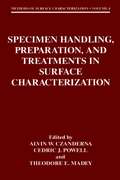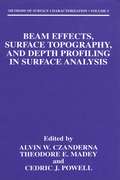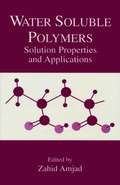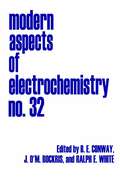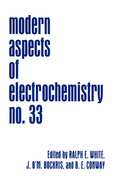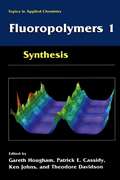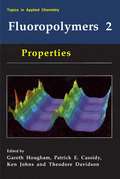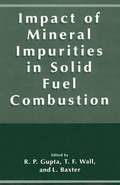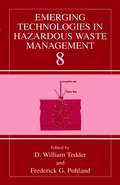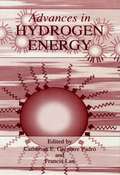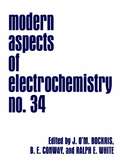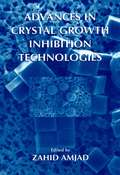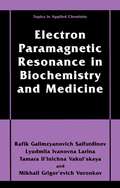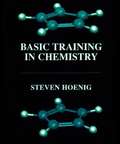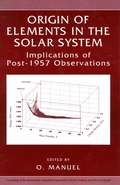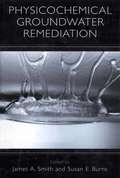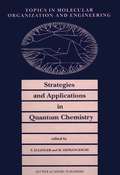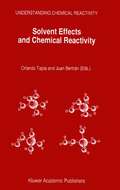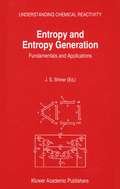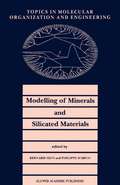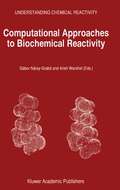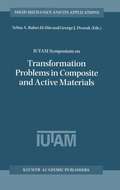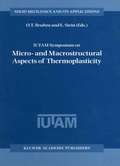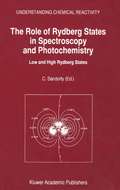- Table View
- List View
Specimen Handling, Preparation, and Treatments in Surface Characterization (Methods of Surface Characterization #4)
by Alvin W. Czanderna Cedric J. Powell Theodore E. MadeyWith the development in the 1960s of ultrahigh vacuum equipment and techniques and electron, X-ray, and ion beam techniques to determine the structure and composition of interfaces, activities in the field of surface science grew nearly exponentially. Today surface science impacts all major fields of study from physical to biological sciences, from physics to chemistry, and all engineering disciplines. The materials and phenomena characterized by surface science range from se- conductors, where the impact of surface science has been critical to progress, to metals and ceramics, where selected contributions have been important, to bio- terials, where contributions are just beginning to impact the field, to textiles, where the impact has been marginal. With such a range of fields and applications, questions about sample selection, preparation, treatment, and handling are difficult to cover completely in one review article or one chapter. Therefore, the editors of this book have assembled a range of experts with experience in the major fields impacted by surface characterization. It is the only book which treats the subject of sample handling, preparation, and treatment for surface characterization. It is full of tricks, cautions, and handy tips to make the laboratory scientist’s life easier. With respect to organization of the book, the topics range from discussion of vacuum to discussion of biological, organic, elemental or compound samples, to samples prepared ex situ or in situ to the vacuum, to deposition ofthin films. Generic considerations of sample preparation are also given.
Beam Effects, Surface Topography, and Depth Profiling in Surface Analysis (Methods of Surface Characterization #5)
by Alvin W. Czanderna Cedric J. Powell Theodore E. MadeyMany books are available that detail the basic principles of the different methods of surface characterization. On the other hand, the scientific literature provides a resource of how individual pieces of research are conducted by particular labo- tories. Between these two extremes the literature is thin but it is here that the present volume comfortably sits. Both the newcomer and the more mature scientist will find in these chapters a wealth of detail as well as advice and general guidance of the principal phenomena relevant to the study of real samples. In the analysis of samples, practical analysts have fairly simple models of how everything works. Superimposed on this ideal world is an understanding of how the parameters of the measurement method, the instrumentation, and the char- teristics of the sample distort this ideal world into something less precise, less controlled, and less understood. The guidance given in these chapters allows the scientist to understand how to obtain the most precise and understood measu- ments that are currently possible and, where there are inevitable problems, to have clear guidance as the extent of the problem and its likely behavior.
Water Soluble Polymers: Solution Properties and Applications
by Zahid AmjadThis volume contains a series of papers originally presented at the symposium on Water Soluble Polymers: Solution Properties and Applications, sponsored by the Division of Colloids and Surface Chemistry of the American Chemical Society. The symposium took place in Las Vegas City, Nevada on 9 to 11th September, 1997 at the 214th American Chemical Society National Meeting. Recognized experts in their - spective fields were invited to speak. There was a strong attendance from academia, g- ernment, and industrial research centers. The purpose of the symposium was to present and discuss recent developments in the solution properties of water soluble polymers and their applications in aqueous systems. Water soluble polymers find applications in a number of fields of which the following may be worth mentioning: cosmetics, detergent, oral care, industrial water treatment, g- thermal, wastewater treatment, water purification and reuse, pulp and paper production, sugar refining, and many more. Moreover, water soluble polymers play vital role in the oil industry, especially in enhanced oil recovery. Water soluble polymers are also used in ag- culture and controlled release pharmaceutical applications. Therefore, a fundamental kno- edge of solution properties of these polymers is essential for most industrial scientists. An understanding of the basic phenomena involved in the application of these polymers, such as adsorption and interaction with different substrates (i. e. , tooth enamel, hair, reverse - mosis membrane, heat exchanger surfaces, etc. ) is of vital importance in developing high performance formulations for achieving optimum efficiency of the system.
Modern Aspects of Electrochemistry (Modern Aspects of Electrochemistry #32)
by John O'M. Bockris Ralph E. White Brian E. ConwayRecognized experts present incisive analysis of both fundamental and applied problems in this continuation of a highly acclaimed series. Topics discussed include: A thorough and mathematical treatment of periodic phenomena, with consideration of new theories about the transition between `order' and `chaos'; Impedance spectroscopy as applied to the study of kinetics and mechanisms of electrode processes; The use of stoichiometric numbers in mechanism analysis; The electro-osmotic dewatering of clays with important implications for the processing of industrial waste and geotechnical; stabilization; Magnetic effects in electrolytic processes and the electrolytic Hall effect; and The computer analysis and modeling of mass transfer and fluid flow. These authoritative studies will be invaluable for researchers in engineering, electrochemistry, analytical chemistry, materials science, physical chemistry, and corrosion science.
Modern Aspects of Electrochemistry (Modern Aspects of Electrochemistry #33)
by Ralph E. White B. E. Conway J. O'M BockrisRecognized experts present incisive analysis of both fundamental and applied problems in this continuation of a highly acclaimed series. Topics discussed include: A review of the literature on the potential-of-zero charge by Trasatti and Lust. A thorough review and discussion of nonequilibrium fluctuations in corrosion processes. A wide-ranging discussion of conducting polymers, electrochemistry, and biomimicking processes. Microwave (photo)electrochemistry, from its origins to today's research opportunities, including its relation to electrochemistry. New fluorine cell design, from model development through preliminary engineering modeling, laboratory tests, and pilot plant tests. A comprehensive account of the major and rapidly developing field of the electrochemistry of electronically conducting polymers and their applications. These authoritative studies will be invaluable for researchers in engineering, electrochemistry, analytical chemistry, materials science, physical chemistry, and corrosion science.
Fluoropolymers 1: Synthesis (Topics in Applied Chemistry)
by Patrick E. Cassidy Theodore Davidson Ken Johns Gareth G. HoughamThe fluorine atom, by virtue of its electronegativity, size, and bond strength with carbon, can be used to create compounds with remarkable properties. Small molecules containing fluorine have many positive impacts on everyday life of which blood substitutes, pharmaceuticals, and surface modifiers are only a few examples. Fluoropolymers, too, while traditionally associated with extreme hi- performance applications have found their way into our homes, our clothing, and even our language. A recent American president was often likened to the tribology of PTFE. Since the serendipitous discovery of Teflon at the Dupont Jackson Laboratory in 1938, fluoropolymers have grown steadily in technological and marketplace importance. New synthetic fluorine chemistry, new processes, and new apprec- tion of the mechanisms by which fluorine imparts exceptional properties all contribute to accelerating growth in fluoropolymers. There are many stories of harrowing close calls in the fluorine chemistry lab, especially from the early years, and synthetic challenges at times remain daunting. But, fortunately, modern techniques and facilities have enabled significant strides toward taming both the hazards and synthetic uncertainties. In contrast to past environmental problems associated with fluorocarbon refrigerants, the exceptional properties of fluorine in polymers have great environmental value. Some fluoropolymers are enabling green technologies such as hydrogen fuel cells for automobiles and oxygen-selective membranes for cleaner diesel combustion.
Fluoropolymers 2: Properties (Topics in Applied Chemistry)
by Gareth Hougham Patrick E. Cassidy Theodore Davidson Ken JohnsThe fluorine atom, by virtue of its electronegativity, size, and bond strength with carbon, can be used to create compounds with remarkable properties. Small molecules containing fluorine have many positive impacts on everyday life of which blood substitutes, pharmaceuticals, and surface modifiers are only a few examples. Fluoropolymers, too, while traditionally associated with extreme high performance applications have found their way into our homes, our clothing, and even our language. A recent American president was often likened to the tribology of PTFE. Since the serendipitous discovery of Teflon at the DuPont Jackson Laboratory in 1938, fluoropolymers have grown steadily in technological and marketplace importance. New synthetic fluorine chemistry, new processes, and new apprecia tion of the mechanisms by which fluorine imparts exceptional properties all contribute to accelerating growth in fluoropolymers. There are many stories of harrowing close calls in the fluorine chemistry lab, especially from the early years, and synthetic challenges at times remain daunting. But, fortunately, modem techniques and facilities have enabled significant strides toward taming both the hazards and synthetic uncertainties, In contrast to past environmental problems associated with fluorocarbon refrigerants, the exceptional properties of fluorine in polymers have great environmental value. Some fluoropolymers are enabling green technologies such as hydrogen fuel cells for automobiles and oxygen selective membranes for cleaner diesel combustion.
Impact of Mineral Impurities in Solid Fuel Combustion
by R. Gupta T. Wall L. BaxterThis book contains papers presented at the Engineering Foundation Conference on mineral matter in fuels held on November 2-7, 1997 in Kona, Hawaii. The conference is one of a continuing series that was initiated by the CEGB Mar- wood Engineering Laboratories in 1963. The conference was to be eventually organised by the Engineering Foundation as the need for multi-disciplinary work related to c- trolling ash effects in combustors became apparent. The conference covers both the science and the applications. The papers also present case histories, particularly for current fuel technologies, developments in advanced technologies for power generation and mathematical modelling of these processes. Developments since 1963 have been slow, but steady, due to the complexity of the chemical and physical processes involved. However, the research presented here displays great improvement in our understanding of the mechanisms by which mineral matter will influence fuel use. Steve Benson from EERC presented a review and current status of issues related to ash deposition in coal combustion and gasification. The application of new analytical tools, which have been detailed in the previous conferences, is presented. These include CCSEM, as well as new techniques for char- terising sintering of ash, such as TMA, image analysis, X-ray diffraction crystallography and thermal analysis. The new analytical techniques were extended to encompass widely differing fuels such as biomass. Ole H Larsen from ELSAM Denmark presented a review of these advanced techniques.
Emerging Technologies in Hazardous Waste Management 8
by D. William Tedder Frederick G. PohlandSeveral long-term trends in technology evolution have become apparent since these symposia began in 1989. Earlier presenters more frequently discussed treatment methods involving harsh and extensive human intervention. As the symposia have continued, the number of presentations describing extremely harsh and expensive treatment technologies have gradually been supplanted by more subtle and gentler methods. Such methods include subsurface-engineered barriers, phytoremediation, and bioremediation. Nineteen manuscripts were selected for inclusion in this volume, based upon peer review, scientific merit, the editors' perceptions of lasting value or innovative features, and the general applicability of either the technology itself or the scientific methods and scholarly details provided by the authors. General topics include: soil treatment, groundwater treatment, and radioactive waste treatment.
Advances in Hydrogen Energy
by Catherine E. Grégoire Padró Francis LauIn the future, our energy systems will need to be renewable and sustainable, efficient and cost-effective, convenient and safe. Hydrogen has been proposed as the perfect fuel for this future energy system. The availability of a reliable and cost-effective supply, safe and efficient storage, and convenient end use of hydrogen will be essential for a transition to a Hydrogen Economy. Research is being conducted throughout the world for the development of safe, cost-effective hydrogen production, storage, and end-use technologies that support and foster this transition. This book is a collection of important research and analysis papers on hydrogen production, storage, and end-use technologies that were presented at the American Chemical Society National Meeting in New Orleans, Louisiana, USA, in August 1999.
Modern Aspects of Electrochemistry (Modern Aspects of Electrochemistry #34)
by Ralph E. White Brian E. Conway John O'M. BockrisRecognized experts present incisive analysis of both fundamental and applied problems in this continuation of a highly-acclaimed series. Topics discussed include: The way in which electrochemical systems may function as on a single electrode; The foundational area of voltaic measurements at liquid interfaces; Direct methanol fuel cells, which would avoid the unpleasant necessity faced by the current general of fuel cells - namely, using hydrogen; Dynamic processes in molten salts; Electrochemical techniques and Microbial Induced Corrosion (MIC).
Advances in Crystal Growth Inhibition Technologies
by Zahid AmjadIn this book, academic researchers and technologists will find important information on the interaction of polymeric and non-polymeric inhibitors with a variety of scale forming crystals such as calcium phosphates, calcium carbonate, calcium oxalates, barium sulfate, calcium pyrophosphates, and calcium phosphonates. Moreover, the book delivers information to plant managers and formulators who would like to broaden and deepen their knowledge about processes involved in precipitation of sparingly soluble salts and learn more about the inhibitory aspects of various commercially available materials. Furthermore, experienced researchers will obtain fruitful and inspiring ideas from the easily accessible information about overlapping research areas, which will promote discoveries of new inhibitors (synthetic and/or natural) for the currently unmet challenges.
Electron Paramagnetic Resonance in Biochemistry and Medicine (Topics in Applied Chemistry)
by Rafik Galimzyanovich Sajfutdinov Lyudmila Ivanovna Larina Tamara Il'inichna Vakul'skaya Mikhail Grigor'evich VoronkovElectron Paramagnetic Resonance (EPR) spectroscopy - also sometimes termed Electron Spin Resonance spectroscopy - has manifold potential uses in biochemistry and medicine. The paramount importance of EPR spectroscopy applied to biological tissues and fluids is that it identifies the changes in redox processes that contribute to disease. EPR spectroscopy has come a long way from its original use to detect malignant tumors. For example, the development and later refinement of methods of low-temperature registration of biological tissues widened the scope of EPR spectroscopy. Innovations made possible by the introduction of spin labels, probes, and traps made EPR spectroscopy ever more applicable to biochemistry and medicine, to the point where in vivo studies are being carefully considered. This comprehensive book discusses spectra of many tissues and bodily fluids, and the quantitative nature of paramagnetic centers in both normal individuals and patients suffering from a variety of diseases. Special attention is given to the EPR examination of bio-molecules, such as enzymes, polypeptides, vitamins, lipids, hydrocarbons, etc., which play an essential role in human activity. This book will be of great interest to physicians specializing in many different areas. Similarly, biologists, biochemists, biophysicists, and chemists will find this book very useful. It has also been written so that it may be used as a textbook at graduate level.
Basic Training in Chemistry
by Steven HoenigBasic Training in Chemistry is unique in that it gathers into one source the essential information that is usually widely dispersed. This book can be used as a quick reference guide to the different disciplines of Chemistry: the areas covered are General, Inorganic, Organic, and Instrumental Analysis. Although comprehensive in nature, Basic Training in Chemistry is not meant to replace any standard textbook but rather to be a supplement or additional source of information, or even a comprehensive review guide. Basic Training in Chemistry is a useful addition to any academic or commercial laboratory setting where access to a wide variety of information is needed. The book can be an exceptional source of information for the undergraduate or graduate student as well as for the experienced chemist. Anyone needing a single source of information covering several different disciplines will find this book to be an excellent addition to their usual references.
Origin of Elements in the Solar System: Implications of Post-1957 Observations
by Oliver K. ManuelBased on an American Chemical Society Symposium organized by Professors Glenn Seaborg and Oliver Manuel, this volume provides a comprehensive record of different views on this important subject at the end of the 20th century. They have assembled a blend of highly respected experimentalists and theorists from astronomy, geology, meteoritics, planetology and nuclear chemistry and physics to discuss the origin of elements in the solar system. The intent was to include all points of view and let history judge their validity.
Physicochemical Groundwater Remediation (Aids Prevention And Mental Health Ser.)
by James A. SmithAs we transition into the 21st century, it is apparent that this is an exciting time for environmental engineers and scientists studying remediation technologies. There has been a rapid development of new ways to clean-up polluted groundwater. Research activities of the past and next 10 years will have a dramatic impact on the quality of the subsurface environment for the next century. In 20, or even 10 years from now, our approach to subsurface remediation will probably be vastly different than it is today. Many of the emerging technologies presented in this book will form the basis of standard remediation practices of the future. Physicochemical Groundwater Remediation presents detailed information on multiple emerging technologies for the remediation of the contaminated subsurface environment. All of these technologies apply our knowledge of physical and chemical processes to clean up ground water and the unsaturated zone, and many (if not all) of these emerging technologies will help define standard practices in the future. These technologies include in situ sorptive and reactive treatment walls, surfactant-enhanced aquifer remediation, optimization analyses for remediation system design, chemical, electrochemical, and biochemical remediation processes, and monitored natural attenuation. You will learn how palladium catalyzes the dehalogenation of chlorinated solvents. You will find out how barometric pumping can naturally remove significant quantities of volatile organic pollutants from shallow ground water and the unsaturated zone. You can learn about mobilizing non-aqueous phase liquids (NAPLs) without risking significant downward migration of the NAPL. You can find out how processes such as electroosmosis and electromigration can be exploited for groundwater remediation purposes and how zero-valent iron and zeolite treatment walls can be used in situ to treat and control contaminant plume migration. Contributors to this book are experts in groundwater remediation processes, and they represent industry, consulting, academia, and government. If your work involves the clean up of contaminated soil and groundwater, this book is an essential reference to keep you up to date on the most promising new developments in remediation research.
Strategies and Applications in Quantum Chemistry: From Molecular Astrophysics to Molecular Engineering (Topics in Molecular Organization and Engineering #14)
by Y. Ellinger M. DefranceschiAt the time when increasing numbers of chemists are being attracted by the fascination of supposedly easy computing and associated colourful imaging, this book appears as a counterpoint. The first part focuses on fundamental concepts of quantum chemistry, covering MCSCF theory, perturbation treatments, basis set developments, density matrices, wave function instabilities to correlation effects, and momentum space theory. The second part is devoted to more practical studies, ranging from the characterisation of exotic interstellar molecules, the accurate determination of spectroscopic constants, excited states structures and EPR parameters through photochemical and charge-transfer processes, cluster chemistry and fullerenes, muonium chemistry, to the possible prediction of the response of materials to electric fields in view of nonlinear optical applications. Audience: Graduate students and researchers whose work involves quantum chemistry, molecular physics, and materials modelling.
Solvent Effects and Chemical Reactivity (Understanding Chemical Reactivity #17)
by Orlando Tapia Juan BertránThis book gathers original contributions from a selected group of distinguished researchers that are actively working in the theory and practical applications of solvent effects and chemical reactions. The importance of getting a good understanding of surrounding media effects on chemical reacting system is difficult to overestimate. Applications go from condensed phase chemistry, biochemical reactions in vitro to biological systems in vivo. Catalysis is a phenomenon produced by a particular system interacting with the reacting subsystem. The result may be an increment of the chemical rate or sometimes a decreased one. At the bottom, catalytic sources can be characterized as a special kind of surrounding medium effect. The materials involving in catalysis may range from inorganic components as in zeolites, homogenous components, enzymes, catalytic antibodies, and ceramic materials. . With the enormous progress achieved by computing technology, an increasing number of models and phenomenological approaches are being used to describe the effects of a given surrounding medium on the electronic properties of selected subsystem. A number of quantum chemical methods and programs, currently applied to calculate in vacuum systems, have been supplemented with a variety of model representations. With the increasing number of methodologies applied to this important field, it is becoming more and more difficult for non-specialist to cope with theoretical developments and extended applications. For this and other reasons, it is was deemed timely to produce a book where methodology and applications were analyzed and reviewed by leading experts in the field.
Entropy and Entropy Generation: Fundamentals and Applications (Understanding Chemical Reactivity #18)
by J. S. ShinerEntropy and entropy generation play essential roles in our understanding of many diverse phenomena ranging from cosmology to biology. Their importance is manifest in areas of immediate practical interest such as the provision of global energy as well as in others of a more fundamental flavour such as the source of order and complexity in nature. They also form the basis of most modern formulations of both equilibrium and nonequilibrium thermodynamics. Today much progress is being made in our understanding of entropy and entropy generation in both fundamental aspects and application to concrete problems. The purpose of this volume is to present some of these recent and important results in a manner that not only appeals to the entropy specialist but also makes them accessible to the nonspecialist looking for an overview of the field. This book contains fourteen contributions by leading scientists in their fields. The content covers such topics as quantum thermodynamics, nonlinear processes, gravitational and irreversible thermodynamics, the thermodynamics of Taylor dispersion, higher order transport, the mesoscopic theory of liquid crystals, simulated annealing, information and biological aspects, global energy, photovoltaics, heat and mass transport and nonlinear electrochemical systems. Audience: This work will be of value to physicists, chemists, biologists and engineers interested in the theory and applications of entropy and its generation.
Modelling of Minerals and Silicated Materials (Topics in Molecular Organization and Engineering #15)
by B. Silvi P. D'ArcoThe modeling of minerals and silicated materials is a. difficult challenge faced by Solid StatePhysics, Quantum Chemistry and Molecular Dynamics communities. The difficulty of such a modeling is due to the wide diversity of elements, including heavy atoms,and types of bonding involved in such systems. Moreover, one has to consider infinite systems: either perfect cr- tals or glasses and melts. In the solid state a given chemical composition gives rise to numerous polymorphs, geometricallycloselyrelated. These polymorphs have very similar energies and related thermodynamical pr- erties which explain the complexity of their phase diagrams. The modeling of silicates and minerals covers a wide field of applications ranging from basic research to technology, from Solid State Physics to Earth and Planetary science. The use of modeling techniques yields information of different nature. In the case of chemical studies, we can mention inv- tigations on catalytic processes occurring on surfaces and in zeolite cages. These calculations find possible applications in chemical engineering, in particular in the oil industry.
Computational Approaches to Biochemical Reactivity (Understanding Chemical Reactivity #19)
by Arieh Warshel Gábor Náray-SzabóA quantitative description of the action of enzymes and other biological systems is both a challenge and a fundamental requirement for further progress in our und- standing of biochemical processes. This can help in practical design of new drugs and in the development of artificial enzymes as well as in fundamental understanding of the factors that control the activity of biological systems. Structural and biochemical st- ies have yielded major insights about the action of biological molecules and the mechanism of enzymatic reactions. However it is not entirely clear how to use this - portant information in a consistent and quantitative analysis of the factors that are - sponsible for rate acceleration in enzyme active sites. The problem is associated with the fact that reaction rates are determined by energetics (i. e. activation energies) and the available experimental methods by themselves cannot provide a correlation - tween structure and energy. Even mutations of specific active site residues, which are extremely useful, cannot tell us about the totality of the interaction between the active site and the substrate. In fact, short of inventing experiments that allow one to measure the forces in enzyme active sites it is hard to see how can one use a direct experimental approach to unambiguously correlate the structure and function of enzymes. In fact, in view of the complexity of biological systems it seems that only computers can handle the task of providing a quantitative structure-function correlation.
IUTAM Symposium on Transformation Problems in Composite and Active Materials: Proceedings of the IUTAM Symposium held in Cairo, Egypt, 9–12 March 1997 (Solid Mechanics and Its Applications #60)
by Yehia A. Bahei-El-Din George J. DvorakThe field of composite materials has seen substantial development in the past decade, New composite systems are being continually developed for various applications. Among such systems are metal, intermetallic, and superalloy matrix composites, carbon-carbon composites as well as polymer matrix composites. At the same time, a new discipline has emerged of active or smart materials, which are often constructed as composite or heterogeneous media and structures. One unifying theme in these diverse systems is the influence that uncoupled and coupled eigenfields or transformation fields exert on the various types of overall response, as well as on the respective phase responses. Problems of this kind are currently considered by different groups which may not always appreciate the similarities of the problems involved. The purpose of the IUTAM Symposium on Transformation Problems in Composite and Active Materials held in Cairo, Egypt from March 10 to 12, 1997 was to bring together representatives of the different groups so that they may interact and explore common aspects of these seemingly different problem areas. New directions in micromechanics research in both composite and active materials were also explored in the symposium. Specifically, invited lectures in the areas of inelastic behavior of composite materials, shape memory effects, functionally graded materials, transformation problems in composite structures, and adaptive structures were delivered and discussed during the three-day meeting. This book contains the printed contributions to the IUTAM Symposium.
IUTAM Symposium on Micro- and Macrostructural Aspects of Thermoplasticity: Proceedings of the IUTAM Symposium held in Bochum, Germany, 25–29 August 1997 (Solid Mechanics and Its Applications #62)
by O. T. Bruhns E. SteinProceedings of the IUTAM Symposium held in Bochum, Germany, 25-29 August 1997
IUTAM Symposium on Rheology of Bodies with Defects: Proceedings of the IUTAM Symposium held in Beijing, China, 2–5 September 1997 (Solid Mechanics and Its Applications #64)
by Ren Ren WangThe IUTAM Symposium on Rheology of Bodies with Defects was held in Beijing in September, 1997. It was aimed at the development of Rheology in Solid Mechanics. Rheology is classified in Applied Mechanics Review under fluid mechanics, however, in its broadest content as was envisaged in its earlier days, it covers the whole spectrum of material behavior from elasticity, plasticity, and fluid mechanics to gas dynamics. It was thought of as a branch of continuum mechanics, but emphasized the physical aspects of different materials, and frequently proceeded from basic physical principles. As the temperature rises, the distinction between solid and fluid, and the distinction between their micro-mechanical movements, become blurred. The physical description of such materials and their movements must be based on the thermodynamic principles of state variable theory; the classical division between solid and fluid mechanics disappears. Under the classification adopted by Applied Mechanics Reviews, the subjects dealt with in this symposium come closer to viscoelasticity and viscoplasticity, especially close to the subdivision of creep dealing with creep rupture. The symposium focused at building a bridge between macroscopic and microscopic research on damage and fracture behavior of defective bodies made of metal, polymer, composite and other viscoelastic materials. Two different approaches are presented at the symposium. The first is a continuum damage theory for time-dependent evolution of defects at the macro/meso/microscopic levels.
The Role of Rydberg States in Spectroscopy and Photochemistry: Low and High Rydberg States (Understanding Chemical Reactivity #20)
by C. SándorfyThe aim of this volume is to offer a balanced overview of molecular Rydberg spectroscopy as it has developed over recent decades. Recent evolution has split Rydberg spectroscopy into two apparently distinct fields: the one concerns the low (n=3-5) Rydberg states, the other the very high (typically n>150) Rydberg states. The former is aimed at spectral levels where Rydberg, valence-shell, and intermediate-type states interact, with a variety of photochemical consequences. The latter considers states extremely close to the ionization limit, from whereionization is possible with a very slight amount of additional energy. Recently developed techniques make it possible to produce ions in well-defined electronic, vibrational and rotational states, including states resulting from spin-orbit or Jahn-Teller splitting. It is then possible to study the structure and reactions of such state-selected ions as well as those of the corresponding neutral molecules. These techniques amount to badly needed high resolution photoelectron spectroscopy.
